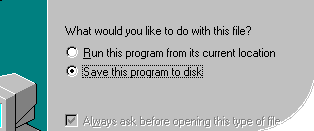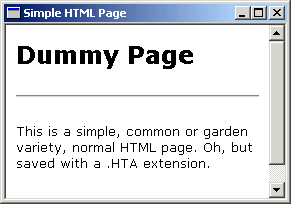HTML Applications - Introducing the HTA File
We all know what a .HTM file. But what about a .HTA file? The two are closely
related, yet very different. Let me explain.
The letters HTA are meant to stand for HTML Application. The technology was
developed by Microsoft, so is a proprietary concept, and only works in
conjunction with Internet Explorer (specifically version 5 and above).
When you follow a link in a Web page to a file that the browser does not know
how to render, such as a .ZIP file, the What would you like to do with this
file? dialog box displays.

The same dialog will appear when you follow a link to a .HTA file, because
the browser itself doesn't recognise it as something that it can display (or
'render') itself. However, the environment is aware, though, that an HTA file
can be executed just like a .EXE file. So you can think of an HTA file as being
much like an EXE file, but with a .HTA file extension.
But that still doesn't fully explain the HTA format, because it is in
actuality quite different from an EXE file. Our first example will give us a
closer understanding.
Example 1 - Rename .HTM to .HTA
One method of creating an HTA file is to rename an existing HTML file with a
.HTA extension. Nothing else. When a link in a Web page to the .HTA file is
followed, the What would you like to do with this file? dialog. You can
try it yourself by following this link to a simple HTA
file. If you select Run this program from its current location, the
HTML file will open in its own Internet Explorer-like window. Not, mind you, an
IE window, but an IE-like window.

This is all very interesting, but it's not actually useful, is it? Why not
just link to a .HTM file, and do away with the What would you like to do...
dialog box? Let's play around a bit, and see what else we can do with an HTML
file named as a .HTA.
Example 2 - Adding HTA Attributes
If we add a block of code to the <head> section of the HTML code in the
.HTA file, we can control some aspects of the display window. For example, by
adding the following within the <head> section of the HTML code, we can
modify the window attributes.
<HTA:APPLICATION id="hwHTA"
applicationName="hyperHTA"
border="thin"
borderStyle="normal"
caption="yes"
icon="http://www.hyperwrite.com/features/favicon.ico"
maximizeButton="yes"
minimizeButton="yes"
showInTaskbar="no"
windowState="normal"
innerBorder="yes"
navigable="yes"
scroll="auto"
scrollFlat="yes"
singleInstance="yes"
sysMenu="no"
contextMenu="yes"
selection="yes"
version="1.0" />
You can try this now yourself by following this
link to another .HTA file.
By the way, the navigable property determines whether a hypertext link
will open in the same HTA window (yes) or in the default browser window
(typically Internet Explorer). A table at the bottom of
this page describes the other properties. If you choose to save an HTA file to
your hard drive, then any icon file referenced becomes the icon for the file's
shortcut, so it will look distinctive, and certainly different from a standard
HTM file.
So now, you may be thinking of some circumstances in which an HTA file might
make sense.
Why Use HTAs?
You are probably aware that dynamic HTML (which is a combination of style
sheets, JavaScript and the Document Object Model) provides the power to build
mini-applications. For example, you can use DHTML to build a card game into an
HTML page. If you wanted this DHTML application to behave more like a program
than a Web page, you could choose to distribute it as an HTA file. And
importantly, the HTA format gives you control over the user interface that
normal scripting does not let you have over the Internet Explorer interface.
HTAs are really useful in many similar situations. If you are prototyping an
idea, building wizard interfaces, or testing Web forms, the HTA concept could be
a godsend. Building prototypes of a Web application is probably the most
important use for HTA files. Without having to code the behind-the-scenes
processing, an interface designer could create the form fields, drop-downs, and
other interface elements, and code simple message boxes to illustrate how the
real system would work.
Security Issues
HTAs have the potential to carry out actions that Netscape or Internet
Explorer would never permit in a Web page. The purpose of this
"trusted" status is so that an application can run seamlessly, without
annoying alerts and warnings. So once running, script inside the HTA file can
manipulate your PC. Maybe it will alarm you to know that HTAs have read/write
access to the files and system registry on the client PC.
With this power comes responsibility. You should exercise caution when
embedding ActiveX and Java controls in your HTA, to prevent yourself
accidentally distributing viruses or other malicious code.
HTA Application Properties Table
| applicationName |
Sets the name of the application, which is
used by the singleInstance attribute to determine whether other instances
of the HTA are running. |
| border |
Sets the window border format. Options are
thin, dialog, none, and thick |
| borderStyle |
Sets the border style settings. Options are
complex, normal, raised, static, and sunken. |
| caption |
Indicates whether the HTML title (from the
<head> section) should appear in the window title bar. Options are
yes and no. |
| icon |
Nominates the URL of the icon to be used in
the window title bar. This must be a 32 x 32 pixel icon in .ICO format. |
| maximizeButton |
Indicates whether the window will include a
maximize button. Options are yes and no. |
| minimizeButton |
Indicates whether the window will include a
minimize button. Options are yes and no. |
| showInTaskbar |
Indicates whether the window will appear in
the Windows task bar. Options are yes and no. |
| windowState |
Describes how the window will initially
display. Options are normal, minimize, and maximize. |
| innerBorder |
Indicates whether the window will include an
inner border. Options are yes and no. |
| navigable |
Indicates whether links will open in the
same window, or in the default browser window. Options are yes (same
window) and no (browser window). |
| scroll |
Indicates whether the window will include a
scroll bar. Options are yes and no. |
| scrollFlat |
Indicates whether a scroll bar will be 3D or
not. Options are yes and no. |
| singleInstance |
Indicates whether only one instance of the
application can be run at one time. This can avoid multiple instances of
the HTA being run. Options are yes and no. |
| sysMenu |
Indicates whether a system menu is displayed
when the icon in the title bar is clicked. Options are yes and no. |
| contextMenu |
Indicates whether a context menu is
displayed when an object on the HTA is right-clicked. Options are yes and
no. You can use this feature to effectively prevent your HTML code from
being viewed, or the content being printed, as these options are normally
accessible within an HTA file from the context menu only. |
| selection |
Indicates whether text within the HTA window
can be selected with the mouse or keyboard. Options are yes and no. |
| version |
Sets the version number of the HTA
application. This can later be retrieved by code within the HTA page. |
More Information
Microsoft
Introduction to HTML Applications